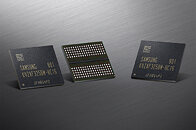- Joined
- Aug 19, 2017
- Messages
- 2,834 (1.03/day)
During Samsung's Tech Day 2021, the company presented some interesting insights about the future of system memory technologies and how it plans to execute its production. Starting with the latest DDR5 standard, the company intends to follow JEDEC documents and offer some overclocking modules that surpass the specification advised by JEDEC. While the DDR5 standard specifies memory modules with 6,400 MT/s, Samsung will develop modules capable of overclocking up to 8,400 MT/s. These are not yet confirmed as they are still in the development phase. However, we can expect to see them in the later life of DDR5 memory.
The company also talked about the DDR6 standard, which is supposedly twice as fast as DDR5. The new DDR6 standard is still in early development, and all we know so far is that the number of memory channels per module is seeing a twofold increase over DDR5 to four channels. The number of memory banks also increases to 64. In addition to DDR6 for desktop and server use cases, the company is also working on Low Power DDR6 (LPDDR6) for mobile applications. While the company's LPDDR5 memory goes into volume production using the 1a-nm process at the beginning of 2022, the LPDDR6 is still in early development. The base speed for DDR6 modules will allegedly arrive at 12,800 MT/s, while overclocking modules will join the party at up to 17,000 MT/s. Mobile-oriented LPDDR6 version is also supposed to come with up to 17,000 MT/s speeds.

Next up, Samsung talked about its memory offerings for graphics, where GDDR and HBM come into play. The new GDDR standard that is supposed to arrive is GDDR6+, which bumps the speed from 18,000 MT/s to 24,000 MT/s. Node of choice for GDDR6+ will be 1z nm, and the Korean giant wants to start manufacturing these modules this month. After this, the company's roadmaps show that the GDDR7 standard will replace GDDR6+ and offer rates of 32,000 MT/s. With GDDR7, there will also be a new feature present called "real-time error protection feature," which is still unknown. Presumably, it is some form of ECC for GDDR or something similar. We are yet to see.
In addition, the company also mentioned that its HBM3 memory will be ready for mass production in the second quarter of 2022, with speeds of 800 GB/s. This memory will target mainly AI applications, and Samsung is working with partners to equip new solutions with HBM3.
View at TechPowerUp Main Site
The company also talked about the DDR6 standard, which is supposedly twice as fast as DDR5. The new DDR6 standard is still in early development, and all we know so far is that the number of memory channels per module is seeing a twofold increase over DDR5 to four channels. The number of memory banks also increases to 64. In addition to DDR6 for desktop and server use cases, the company is also working on Low Power DDR6 (LPDDR6) for mobile applications. While the company's LPDDR5 memory goes into volume production using the 1a-nm process at the beginning of 2022, the LPDDR6 is still in early development. The base speed for DDR6 modules will allegedly arrive at 12,800 MT/s, while overclocking modules will join the party at up to 17,000 MT/s. Mobile-oriented LPDDR6 version is also supposed to come with up to 17,000 MT/s speeds.

Next up, Samsung talked about its memory offerings for graphics, where GDDR and HBM come into play. The new GDDR standard that is supposed to arrive is GDDR6+, which bumps the speed from 18,000 MT/s to 24,000 MT/s. Node of choice for GDDR6+ will be 1z nm, and the Korean giant wants to start manufacturing these modules this month. After this, the company's roadmaps show that the GDDR7 standard will replace GDDR6+ and offer rates of 32,000 MT/s. With GDDR7, there will also be a new feature present called "real-time error protection feature," which is still unknown. Presumably, it is some form of ECC for GDDR or something similar. We are yet to see.
In addition, the company also mentioned that its HBM3 memory will be ready for mass production in the second quarter of 2022, with speeds of 800 GB/s. This memory will target mainly AI applications, and Samsung is working with partners to equip new solutions with HBM3.
View at TechPowerUp Main Site







 I have none
I have none